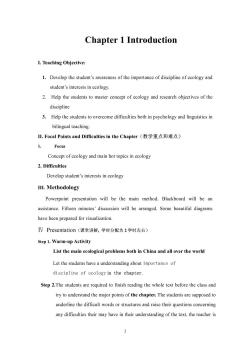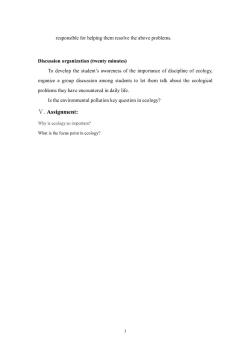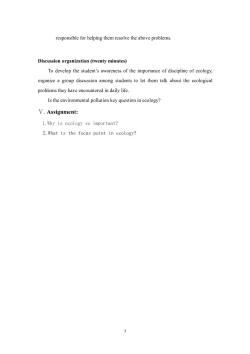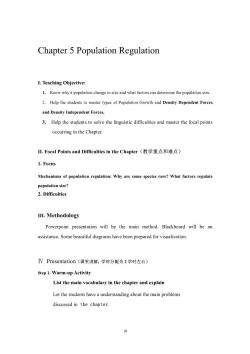华南农业大学:《农业生态学》课程授课教案 Teaching Plan for Agricultural Ecology(负责人:曾任森,打印版)

Teaching Plan for Agricultural Ecology (Bilingual Teaching) Textbook: Ecology: Principles and applications (Chapman J L and Reiss M J eds, Cambridge Univ. Press, 1999) Teacher: Ren-sen Zeng 《农业生态学》(中英文双语教学)教案 任课教师:曾任森教授 教材(英文原版):Ecology: Principles and applications (Chapman JL and Reiss MJ主编,剑桥大学出版社,1999)(影印版,清华大学出 版社,2003)

Chapter 1 Introduction I.Teaching Objective: 1.Develop the student's awareness of the importance of discipline of ecology and student's interests in ecology. 2.Help the students to master concept of ecology and research objectives of the discipline 3.Help the students to overcome difficulties both in psychology and linguistics in bilingual teaching. IL.Focal Points and Difficulties in the Chapter(教学重点和难点) 1. Focus Concept of ecology and main hot topics in ecology 2.Difficulties Develop student's interests in ccology Methodology Powerpoint presentation will be the main method.Blackboard will be an assistance.Fifteen minutes'discussion will be arranged.Some beautiful diagrams have been prepared for visualization. V Presentation(课堂讲解,学时分配为2学时左右) Step 1.Warm-up Activity List the main ecological problems both in China and all over the world Let the students have a understanding about importance of discipline of ecology in the chapter. Step 2.The students are required to finish reading the whole text before the class and try to understand the major points of the chapter.The students are supposed to underline the difficult words or structures and raise their questions concering any difficulties their may have in their understanding of the text,the teacher is

responsible for helping them resolve the above problems Discussion organization(twenty minutes) To develop the student's awareness of the importance of discipline of ecology. organize a group discussion among students to let them talk about the ecological problems they have encountered in daily life. Is the environmental pollution key question in ecology? V.Assignment: Why is ecology so important? What is the focus point in ecology?

Chapter 1 Individual I.Teaching Objective: 1.Develop the student's awareness of the importance of individual,autotrophs and heterotrophs. 2.Help the students to master terms associated with autotrophic and heterotrophic nutrition 3.Help the students to overcome difficulties both in psychology and linguistics in bilingual teaching. L.Focal Points and Difficulties in the Chapter(教学重点和难点) 1.Focus autotrophs and heterotrophs. 2.Difficulties Develop student's interests in ccology Methodology Powerpoint presentation will be the main method.Blackboard will be an assistance.Fifteen minutes'discussion will be arranged.Some beautiful diagrams have been prepared for visualization. V Presentation(课堂讲解,学时分配为2学时左右) Step 1.Warm-up Activity List the main ecological problems both in China and all over the world Let the students have a understanding about importance of discipline of ecology in the chapter. Step 2.The students are required to finish reading the whole text before the elass and try to understand the major points of the chapter.The students are supposed to underline the difficult words or structures and raise their questions concering any difficulties their may have in their understanding of the text,the teacher is

responsible for helping them resolve the above problems Discussion organization(twenty minutes) To develop the student's awareness of the importance of discipline of ecology. organize a group discussion among students to let them talk about the ecological problems they have encountered in daily life. Is the environmental pollution key question in ecology? V.Assignment: 1.Why is ecology so important? 2.What is the focus point in ecology?

Chapter 3 Autecology I.Teaching Objective: 1.Develop the student's awareness of the important role autecology played in a special survival in the communication through using bracken and European starling as good examples to show the point. 2.Help the students to master life form and survival mechanism of bracken and European starling 3.Help the students to solve the linguistic difficulties and master the focal points occurring in the Chapter. Ⅱ.Focal Points and Difficulties in the Chapter(教学重点和难点) 1.Focus (1)studies adaptations of organisms to their environment; (2)how physiology,morphology,structure,behavior,and other attributes of individuals affect their functioning and survival: (3)basically the study of an organism and the way it functions in its environment(including the physical environment and other organisms). 2.Difficulties Factors influencing the establishment,growth,and survival of the individual Through Examples:bracken and European starling II.Methodology Powerpoint presentation will be the main method.Blackboard will be an assistance.Some beautiful diagrams have been prepared for visualization. 6

IV Presentation(课堂讲解,学时分配为1学时左右) Step 1.Warm-up Activity List the main vocabulary in the chapter and explain Let the students have a understanding about the main problems discussed in the chapter. Step 2.The students are required to finish reading the whole text before the class and try to understand the major points of the chapter.The students are supposed to underline the difficult words or structures and raise their questions concerning any difficulties their may have in their understanding of the text,the teacher is responsible for helping them resolve the above problems. Discussion organization(twenty minutes) To develop the student's awareness of the species survival strategies and mechanisms,organize a group discussion among students to let them talk about the problems they have encountered in daily life Part V.Assignment: Exercises: 1.Draw a frame diagram to show the life cycles of bracken and Europcan starling 2.List all mechanisms which bracken and European starling have for their survival and distribution. Check the assignment of the students and help them to solve the difficulties in their assignment

Chapter 4.Population Dynamics I.Teaching Objective: 1.Develop the student's importance of Population level and Population Dynamics and Ecology. 2.Help the students to master Population Demography. 3.Help the students to know characteristics ofa Populatior L.Focal Points and Difficulties in the Chapter(教学重点和难点) 1.Focus Population demography 2.Difficulties Life table and survivorship curve IⅢ.ethodology Powerpoint presentation will be the main method.Blackboard will be an assistance.Some beautiful diagrams have been prepared for visualization IV Presentation(课堂讲解,学时分配为2学时左右) Step 1.Warm-up Activity List the main vocabulary in the chapter and explain Let the students have a understanding about the main problems discussed in the chapter. Step 2.The students are required to finish reading the whole text before the class and try to understand the major points of the chapter.The students are supposed to underline the difficult words or structures and raise their questions concerning any difficulties their may have in their understanding of the text,the teacher is

responsible for helping them resolve the above problems. Discussion organization(twenty minutes) Life Strategies:-and K-selected life history traits Part V.Assignment: Exercises: Population structure can be described in terms of the age of organisms or the stag of development they have reached.How can demographic data be shown as life tables population pyramids or survivorship curves

Chapter 5 Population Regulation I.Teaching Objective: 1.Know why a population change in size and what factors can determine the population size. 2.Help the students to master types of Population Growth and Density Dependent Forces and Density Independent Forces. 3.Help the students to solve the linguistic difficulties and master the focal points occurring in the Chapter. L,Focal Points and Difficulties in the Chapter(教学重点和难点) 1.Focus Mechanisms of population regulation:Why are some species rare?What factors regulate population size? 2.Difficulties II.Methodology Powerpoint presentation will be the main method.Blackboard will be an assistance.Some beautiful diagrams have been prepared for visualization. V Presentation(课堂讲解,学时分配为2学时左右) Step 1.Warm-up Activity List the main vocabulary in the chapter and explain Let the students have a understanding about the main problems discussed in the chapter
按次数下载不扣除下载券;
注册用户24小时内重复下载只扣除一次;
顺序:VIP每日次数-->可用次数-->下载券;
- 山东农业大学:《农业生态学》课程教学大纲 Agroecology(Bilingual Teaching).doc
- 华南农业大学:《作物栽培学》课程教学资源(实验指导)实验五 水稻产量构成因素调查及产量预测.pdf
- 华南农业大学:《作物栽培学》课程教学资源(实验指导)实验二 水稻分蘖特性观察.pdf
- 华南农业大学:《作物栽培学》课程教学资源(实验指导)实验一 水稻秧苗素质调查.pdf
- 华南农业大学:《作物栽培学》课程授课教案Ⅱ(任课老师:唐湘如).pdf
- 华南农业大学:《作物栽培学》课程教学大纲 Crop Cultivation Science Ⅰ.pdf
- 华南农业大学:《农药残留分析》课程教学资源(教案讲义)第八章 核磁共振、第九章 滴定分析法.doc
- 华南农业大学:《农药残留分析》课程教学资源(教案讲义)第六章 可见紫外分光光度法、第七章 红外光谱法.doc
- 华南农业大学:《农药残留分析》课程教学资源(教案讲义)第五章 高效液相色谱法.doc
- 华南农业大学:《农药残留分析》课程教学资源(教案讲义)第四章 气相色谱法.doc
- 华南农业大学:《农药残留分析》课程教学资源(教案讲义)第一章 绪论、第二章 色谱法、第三章 薄层色谱法.doc
- 华南农业大学:《农药残留分析》课程教学资源(PPT课件)第五章 高效液相色谱法(1/2).ppt
- 华南农业大学:《农药残留分析》课程教学资源(PPT课件)第五章 高效液相色谱法(2/2).ppt
- 华南农业大学:《农药残留分析》课程教学资源(PPT课件)第十一章 农药残留分析概述.ppt
- 华南农业大学:《农药残留分析》课程教学资源(PPT课件)第十二章 农药残留样品的采集.ppt
- 华南农业大学:《农药残留分析》课程教学资源(PPT课件)第七章 红外光谱法.ppt
- 华南农业大学:《农药残留分析》课程教学资源(PPT课件)第八章 滴定分析法.ppt
- 华南农业大学:《农药残留分析》课程教学资源(PPT课件)第六章 可见紫外分光光度法.ppt
- 华南农业大学:《农药残留分析》课程教学资源(PPT课件)第九章 农药理化性能测定法.ppt
- 华南农业大学:《农药残留分析》课程教学资源(PPT课件)第十章 农药分析中的标准样品制备、取样方法和数据处理.ppt
- 华南农业大学:《农业生态学》课程实验指导(打印版)种群和群落生态学实验、农业生态系统的能量测定、农业生态系统的物流测定和结构分析.pdf
- 华南农业大学:《农业生态学》课程教学课件(讲稿)Chapter 1 Introduction Of Agricultural Ecology(1/2).pdf
- 华南农业大学:《农业生态学》课程教学课件(讲稿)Chapter 1 Introduction Of Agricultural Ecology(2/2).pdf
- 华南农业大学:《农业生态学》课程教学课件(讲稿)Chapter 3 个体生态学 Autecology.pdf
- 华南农业大学:《农业生态学》课程教学课件(讲稿)Chapter 5 Population Regulation.pdf
- 华南农业大学:《农业生态学》课程教学课件(讲稿)Chapter 2 The Individual.pdf
- 华南农业大学:《农业生态学》课程教学课件(讲稿)Chapter 4 种群动态 Population Dynamics.pdf
- 华南农业大学:《农业生态学》课程教学课件(讲稿)Chapter 9 Environments.pdf
- 华南农业大学:《农业生态学》课程教学课件(讲稿)Chapter 11 & 12 Trophic Levels & Energy Transfer.pdf
- 华南农业大学:《农业生态学》课程教学课件(讲稿)Chapter 10 Habitat, Niches and population interactions.pdf
- 华南农业大学:《农业生态学》课程教学课件(讲稿)Chapter 13 Nutrient Cycling and Pollution.pdf
- 华南农业大学:《农业生态学》课程教学课件(讲稿)Chapter 14 群落生态学 Community Ecology.pdf
- 华南农业大学:《农业生态学》课程教学课件(讲稿)Chapter 16 群落演替 community succession.pdf
- 华南农业大学:《农业生态学》课程教学课件(讲稿)Chapter 20 & 21 Biodiversity & Conservation 生物多样性及其保护.pdf
- 华南农业大学:《农业生态学》课程教学课件(讲稿)Chapter 15 生态系统 Ecosystems、Chapter 17 世界生物群落类型 Biomes.pdf
- 华南农业大学:《农业生态学》课程教学课件(讲稿)Chapter 22 生态农业 Eco-agriculture.pdf
- 华南农业大学:《果树栽培学》课程教学资源(实验指导)果树系——《荔枝控梢促花研究》指导书及大纲.doc
- 华南农业大学:《果树栽培学》课程教学资源(实验指导)果树系——修剪程度对果树生长的影响.doc
- 华南农业大学:《果树栽培学》课程教学资源(实验指导)果树系——技条环剥处理对果树生物学与生理学效应研究.doc
- 华南农业大学:《果树栽培学》课程教学资源(实验指导)果树系——指导书参考格式.doc
